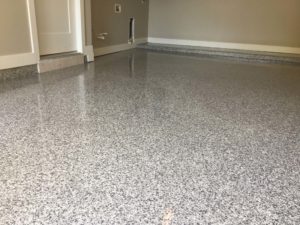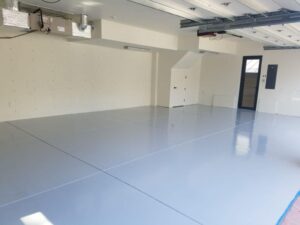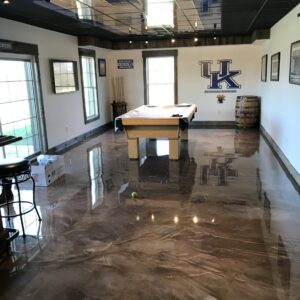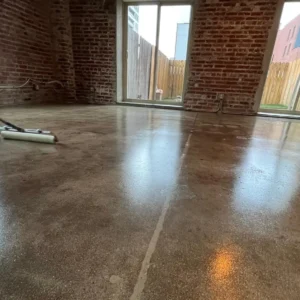Concrete Coatings
Concrete coatings enhance the durability, aesthetics, and functionality of concrete surfaces. Below is a detailed overview of various concrete coatings, including their properties and ideal applications.
Epoxy Coatings
Epoxy coatings are a two-part system (resin and hardener) that cures to form a hard, glossy, and seamless surface. They are highly durable, resistant to stains, chemicals, abrasions, and impacts. Epoxy adheres strongly to properly prepared concrete, creating a long-lasting finish. However, it requires 24-72 hours to cure and can yellow under UV exposure, making it less ideal for outdoor use unless paired with a UV-resistant topcoat.
Ideal Uses: Epoxy is perfect for garage floors, basements, and indoor spaces with moderate to heavy foot traffic. It’s commonly used in residential garages, workshops, and commercial spaces like retail stores or gyms where durability and stain resistance are key.
Epoxy Flake Systems
Epoxy flake systems combine a base epoxy layer with decorative vinyl flakes broadcast into the wet coating. The flakes create a textured, multi-colored finish that hides surface imperfections and adds slip resistance. A clear topcoat (often polyaspartic or polyurethane) seals the flakes, enhancing durability and ease of cleaning. This system is customizable in color, pattern, and flake density.
Ideal Uses: These systems are ideal for residential garages, patios, and basements, as well as commercial spaces like showrooms, offices, or fitness centers. They suit areas where aesthetics, durability, and slip resistance are important, such as high-traffic retail or recreational spaces.



Polyaspartic Coatings
Polyaspartic coatings are a type of polyurea that cure rapidly (often within hours), allowing for quick project turnaround. They offer excellent UV resistance, preventing yellowing in sunlight, and are highly durable against chemicals, abrasions, and stains. Polyaspartics can be used as a standalone coating or as a topcoat over epoxy or flake systems, providing a glossy or matte finish.
Ideal Uses: Polyaspartic coatings are ideal for garage floors, patios, and outdoor concrete surfaces exposed to sunlight. They’re also suited for commercial spaces like restaurants, retail stores, or medical facilities where minimal downtime and UV stability are critical. Their fast cure time makes them perfect for projects with tight schedules.
Polyurethane Coatings
Polyurethane coatings are typically used as a topcoat over epoxy or flake systems, adding UV resistance, scratch resistance, and a glossy or matte finish. They are less durable as a standalone coating but enhance the longevity of underlying systems by protecting against wear and environmental factors. Polyurethane is flexible, making it resistant to minor surface movements.
Ideal Uses: Polyurethane is ideal as a protective topcoat for garage floors, commercial showrooms, or high-traffic areas like lobbies. It’s used in spaces requiring a polished look and added protection, such as retail stores, offices, or residential basements.
Metallic Epoxy
Metallic epoxy incorporates metallic pigments into an epoxy base, creating a reflective, three-dimensional finish that resembles polished metal, marble, or liquid glass. The swirling patterns and vibrant colors are highly customizable, offering a luxurious, high-end appearance. Metallic epoxy is durable, stain-resistant, and easy to clean, though it requires skilled application for consistent results.
Ideal Uses: Metallic epoxy is perfect for residential basements, garages, or entertainment spaces seeking a dramatic, upscale look. It’s also popular in commercial settings like showrooms, salons, restaurants, or retail stores where a visually striking floor enhances the ambiance.



Urethane Cement Coatings
Urethane cement coatings combine urethane, cement, and silica sand to create a thick (1/8 to 1/4 inch), seamless floor. They are exceptionally durable, resistant to thermal shock, moisture, chemicals, and heavy impacts. These coatings can withstand extreme conditions, including frequent cleaning and high temperatures, and are often applied in thick layers for added strength.
Ideal Uses: Urethane cement is ideal for industrial environments like food processing plants, breweries, manufacturing facilities, or commercial kitchens. It’s suited for areas with heavy machinery, high moisture, or stringent hygiene requirements.
Grind and Seal
The grind and seal process involves mechanically grinding the concrete surface to remove imperfections and create a smooth, polished base. A clear sealer, typically epoxy or polyaspartic, is then applied to protect the surface and enhance its appearance. The result is a low-maintenance floor with a natural concrete look, offering moderate durability and stain resistance.
Ideal Uses: Grind and seal is ideal for warehouses, industrial facilities, or utilitarian spaces where a polished yet simple aesthetic is desired. It’s also used in commercial settings like retail stores or offices seeking a cost-effective, durable floor with a minimalist look.
Industrial Line Striping
Industrial line striping involves applying high-performance coatings, typically epoxy or polyaspartic-based, to mark walkways, traffic lanes, or safety zones. These coatings are durable, resistant to chemicals, abrasions, and heavy traffic, and designed for high visibility. They often incorporate reflective additives for low-light environments.
Ideal Uses: Line striping is ideal for warehouses, factories, parking lots, and distribution centers. It’s used to designate pedestrian paths, vehicle lanes, or hazard zones, improving safety and organization in industrial and commercial facilities.


